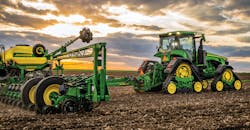From Plant Microclimates to Deep Learning for Weeds, Farming Tech Feeds a Rising Population
The world population is expected to reach nearly 10 billion people by 2050, and farmers are on the front lines of feeding them. This population change will call for a 50% rise in the demand for food, meaning farmers will need to grow more food while using the same or fewer resources. They’ll also have to make this step-function change in productivity and efficiency in the face of numerous challenges inherent to agriculture such as unpredictable weather, labor shortages and less arable land.
Farmers depend on one thing above all else: the land. It’s their workplace, their passion, and their way of providing for their families and all of us, now and in the future. It’s imperative that farmers are able to grow what’s needed today in a way that creates environmental longevity for future generations. These current demands require innovative thinking and new solutions.
One innovation is already occurring: advanced agricultural technology.
Of course, the knowledge, expertise, and critical decision-making skills farmers bring to their operations are irreplaceable, no matter how pervasive technology becomes. However, the advancement of artificial intelligence (AI), Io and geospatial positioning systems (GPS) amplifies what farmers are already doing to accelerate their efficiency and accuracy, and ultimately increase output to provide for our world. Smart robotic machines amplify the senses farmers already use every day, allowing them to scale those senses while making their observations quicker, more efficient, and more precise.
Seeing More with Computer Vision
Computer vision, a type of AI, helps farmers “see” beyond human capacity. AI shows what’s happening at critical junctures, informing important, in-the-moment decisions. For example, a large soybean farm can have approximately 750 million plants growing in one season. Each soybean plant grows in a unique microenvironment as soil conditions can vary from plant to plant. These conditions affect everything, from the size of the soybeans themselves to the yield of each plant. Just as with raising children, farmers need to tend to each plant individually. However, with 750 million plants, it’s impossible to give plants the one-on-one “time” they need. This is where tech such as computer vision, machine learning, and sensors help.
Today, technologically advanced farm equipment leverages computer vision and machine learning to detect the difference between plants and the weeds that threaten their health, so only the weeds are sprayed with herbicides. The equipment uses deep learning, cameras and robotics to understand its surroundings, and it gets smarter over time as it “learns” through images collected as it operates. Computer-vision-enabled agricultural equipment can complete more tasks and focus on growing healthier, more successful crops with fewer herbicides. The result saves on cost while simultaneously improving environmental stewardship.
Precision Technology Is Key to Sustainable Farming Practices
Farmers also rely on connectivity, sensors and GPS to amplify their observations and senses at a speed and scale beyond human capability. For the last two decades, GPS has helped farmers to move enormous equipment through their fields with incredible accuracy. Coupled with sensors, these machines understand their surroundings and lumber through fields without running over crops. By using GPS to map the boundaries of a field and its crops within an inch of the corners, a farmer can “drive” an autonomous tractor from a smartphone, or depend less on human labor in short supply to navigate the fields. By automatically steering according to the GPS boundaries, the tractor can minimize passes in the field, compacting the soil less and preventing crops from being trampled. GPS also frees farmers up for other high-value tasks, such as analyzing data from the machines to better inform their next steps of the season.
The integration of these advanced technologies is made possible through improved connectivity, as well as real-time data collection and sharing via IoT. Before IoT was a reality, farmers waited for harvest before leveraging the data they collected throughout the season. Then that data—typically as applied data of inputs and yield results from each field—was stored in binders and rarely looked at again. Without IoT and GPS data, farmers could not make data-informed decisions. They relied instead on gut instinct, which did not always pan out due to environmental and plant-level variability. Today, farmers have access to real-time data that shows what’s performing and what isn’t. With this data, farmers can proactively manage their day, improve productivity, and increase confidence that jobs are executed as planned and with sustainability in mind.
Revolutionizing Agriculture with Data
Just as consumers are constantly learning and evolving to be more sustainable, so are the farmers providing us with food, fuel, and fiber. For them, it’s a matter of adjusting to changes in the natural world and the impacts of urbanization and adopting technology to address these issues. With innovations such as AI, sensors, GPS, and data analytics, farmers can maximize their output and support our growing world while maintaining the land we all hold so near and dear to our hearts.
Deanna Kovar is vice president of production and Precision Ag production systems, John Deere.
